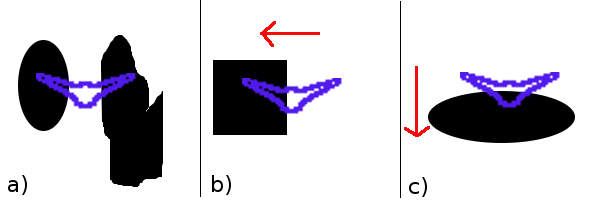
DESCRIPTION
The system represents the interaction between an input image and a flock of birds; the birds act according to a set of rules and its behavior is determined by its current state and the input image. Each bird conducts independently of the rest of its partners. The movement of the birds is drive by an independent search of symmetry in the amount of black pixels that the birds are occluding in the black/white version of the input image. Fig 1 shows some possible cases of occlusion and the movement decision took in each case.

Fig 1. The birds move looking for symmetry in the BW version of the image behind them. a) Bird doesn’t move. b) Bird moves to the left. c) Bird moves down.
Two special cases are also consider, birds over full black and birds over full white. Birds over full black keep moving with short random steps to allow birds to place in the interior region of big black areas. Birds over white make bigger random steps (direction and size are random ), but this movement is made across many frames to guarantee smooth displacement and rapid target (black pixels) localization.
To avoid the observed tendency of the birds to get away of slightly asymmetrical thin black stripes, their behavior is changed to act like they were over only black pixels when just the central part of the bird (the body without wings) indeed is. (Fig 2).

Fig 2. In asymmetric thin stripes birds tend move, leaving black areas uncover, without variation in the algorithm this bird tends to go up, and stay still (with random moves) with the algorithm variations.
The wing flicking is also dependent on the input image, birds over full white move their wings 4 times faster than the other birds.; and finally, the color of each birds is the average of the RGB colors of the occluded region of the input image